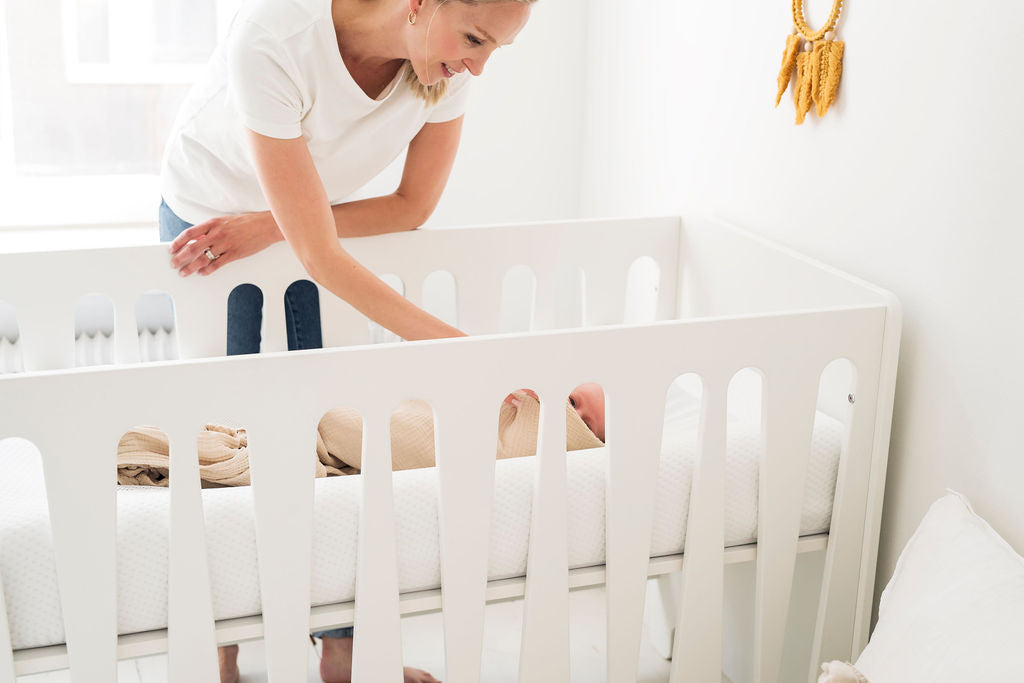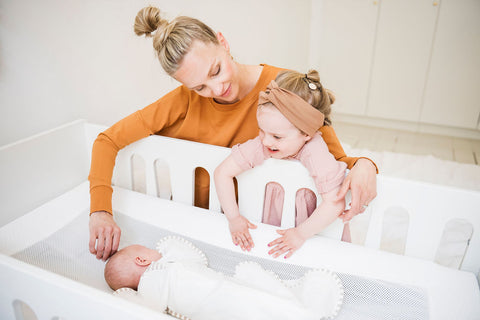Newborns sleep up to 20 hours per day, but that is not always a consolation for the exhausted parents. The broken sleep and lack of rhythm are challenges which must be accepted in the early days. However, you can begin to support the baby’s sleep and its rhythm at an early stage in order to find a sleeping rhythm suitable for the entire family as soon as possible.
The sleep cycles of a baby begin to develop already when they are in the womb. Various cycles of activity and sleep can be observed already after 25 weeks of pregnancy. A full-term baby has clear phases of sleep. However, differences between active and deep sleep do not mean that your baby would sleep soundly right after being born, as they will spend the first 3 to 6 months of their life learning the secrets of a suitable sleeping rhythm.
The sleep of a newborn baby is significantly different from the sleep of an adult. After falling asleep, a baby will go directly into a phase of active sleep, whereas adults face this phase at the end of their cycle. The baby may puff, make other sounds, and move around during active sleep. This may worry the parents, as they may interpret the activity as the poor quality of sleep. However, the movements and sounds are a normal part of active sleeping, and trying to calm down the baby too much may even wake up the baby from deep sleep.
The sleep of a baby and its sleep cycles challenge the parents
Your baby will go through several short periods of sleep during the night, and they may stir or wake up between them. One period lasts for approximately 50 minutes, whereas the similar periods for adults may last for up to 1.5–2 hours. This often means that the baby wakes up right in the middle of the adult’s deep sleep phase, which in turn may make the parent feel drowsy and confused when being woken up. The interruptions to deep sleep are one significant factor in the fatigue of new parents.
Supporting the baby to fall asleep independently between their sleep cycles is important in order to allow the baby as well as the parents to enjoy longer periods of uninterrupted sleep. When the baby stirs between their sleep cycles, being able to feel safe is essential. You can increase this feeling of safety by allowing the baby to fall asleep in the same room where they will wake up, for example. LullaMe Solina is also an excellent tool, as its rocking motion will remind the baby of the environment in the womb, calming them and making it easier to fall asleep again between the sleep cycles. Find out more about the LullaMe Solina here.
Parents supporting the baby's sleeping rhythm
Parents have many means for supporting the sleeping rhythm of their baby. It is worth remembering that newborns naturally sleep the longest uninterrupted period in the daytime, but the parents should gradually begin to steer their rhythm towards sleeping in the nighttime. LullaMe Solina is one of the good ways to support the baby’s sleeping rhythm. The self-rocking Solina calms down and relaxes the baby when it is time to sleep. The rocking motion helps the baby to fall asleep and stay asleep between the sleep cycles.
The baby’s daily rhythm is a significant part of supporting their sleeping rhythm. Babies often learn to recognise the difference between day and night at approximately the age of three months, but getting them used to the difference right away is a good idea. The difference can be emphasised by adjusting the amount of light, level of speaking voice, and amount of activity, for example. The daily rhythm can also be strengthened through repeated evening routines, which function as a transition from the activity of the day to the calmness of the night. It's usually beneficial for the sleep of a baby if the baby gets used to going to sleep around the same time every evening already at the age of a few weeks.
Read more: Three tips for getting your newborn to sleep
To be prepared is half the victory
Even if the baby’s sleeping rhythm begins to even out around the age of six months, it faces several challenges. Teething, illness, burdening days, and the various development stages bring their own flavours to sleeping. However, you can anticipate these unavoidable phases by committing to supporting the baby’s sleeping rhythm early on. If the rhythm is as stable as possible, momentary challenges are easier to beat.
The sleep of a baby develops immensely in no time at all. Even though the baby’s physiological development and eating rhythm largely define how nights go, the parents can support and guide the baby’s sleep in many ways. Every baby and every family is an individual, and finding the right ways of doing things and the best routines just for your family is essential. LullaMe Solina can support every family in the search of a good night’s sleep. Read more about it here or order the 30-day trial period here.





Leave a comment: